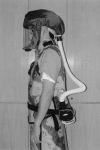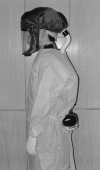Is your interventional radiology service ready for SARS?: The Singapore experience
- PMID: 14753298
- PMCID: PMC7079951
- DOI: 10.1007/s00270-003-0143-5
Is your interventional radiology service ready for SARS?: The Singapore experience
Abstract
The recent epidemic of severe acute respiratory syndrome caught many by surprise. Hitherto, infection control has not been in the forefront of radiological practice. Many interventional radiology (IR) services are therefore not equipped to deal with such a disease. In this review, we share our experience from the interventional radiologist's perspective, report on the acute measures instituted within our departments and explore the long-term effects of such a disease on the practice of IR.
Figures



Comment in
-
Contribution of Interventional Radiology to the Management of COVID-19 patient.Cardiovasc Intervent Radiol. 2020 Jun;43(6):837-839. doi: 10.1007/s00270-020-02470-0. Epub 2020 Apr 22. Cardiovasc Intervent Radiol. 2020. PMID: 32322916 Free PMC article. No abstract available.
References
-
- Centers for Disease Control and Prevention Recommendations for prevention of HIV transmission in health-care settings. MMWR. 1987;36((S2)):1S–18S. - PubMed
-
- Centers for Disease Control and Prevention Update: universal precautions for prevention of transmission of human immunodeficiency virus, hepatits B virus, and other bloodborne pathogens in health-care settings. MMWR. 1988;37:377–382, 387–388. - PubMed
-
- Hansen ME, Bakal CW, Dixon GD, et al. Guidelines regarding HIV and other bloodborne pathogens in vascular/interventional radiology. J Vasc Interv Radiol. 1997;8:667–676. - PubMed
-
- McGowan JE Jr. Nosocomial tuberculosis: new progress in control and prevention. Clin Infect Dis. 1995;21:489–505. - PubMed
-
- World Health Organization Outbreak news - acute respiratory syndrome: China, Hong Kong Special Administrative Region of China and Vietnam. Weekly Epid Rec. 2003;78:73–74. - PubMed
Publication types
MeSH terms
LinkOut - more resources
Full Text Sources
Medical
Miscellaneous

